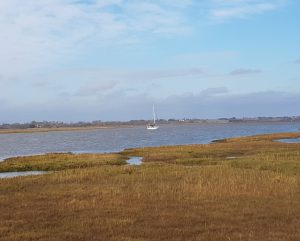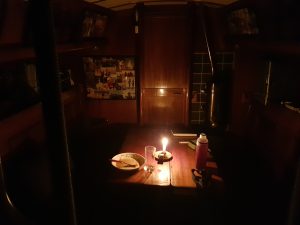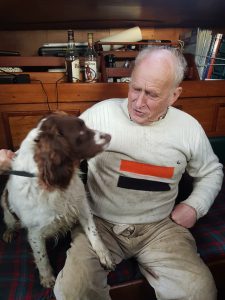Captain Calamity appeared every August, regular as clockwork. He would be an old man sailing a wreck of an old boat that he’d picked up for a song and he would be navigating by road map – usually an out-of-date AA handbook.
And, of course, the lifeboat would go and fetch him.
It is one of the great benefits of sailing in UK waters that the lifeboats are manned by volunteers, funded by charity and free at the point of use.
No matter how many times you use them…
Because, having been towed safely into harbour, Captain Calamity would have a shower in the quayside facilities, a good meal ashore and then set off again – only to get into difficulties once more and be towed in by the next lifeboat down the coast.
At about this point, the lifeboat coxswain would advise the old boy that his vessel was really not seaworthy or he needed some navigation classes or perhaps the whole expedition was a terrible mistake.
It would be at about this point that the newspapers would become involved – and sure enough, at the Daily Mail, I was the recognised “Captain Calamity Correspondent”. I would hasten to Hull or Skegness or wherever and record the next stage of the unfolding disaster because, you see, nobody could stop Captain Calamity. In the UK you don’t need permission to go to sea. You don’t have to have passed exams or carry any safety equipment. If you can put up with the shaking heads on the quay and doleful predictions of the local fishermen, you can go – whatever the Lifeboat coxswain may say.
Sometimes at this stage, the ancient mariner would succumb to the embarrassment he had brought down on himself – sometimes not. Either way, there was usually a good story in it…
Ever since, I have been acutely sensitive to the prospect getting myself smothered in ridicule – like for instance going aground on at the top of the highest tide for the next ten days. Which is what happened today.
If you have been keeping up, you will know about the abortive expedition to fetch water from the pub at Kirby-Le-Soken, trespassing for a pee on Horsey Island and the “Beware Oyster Beds” sign which had blow away. Anyway, yesterday I went round to the marina on the pretext of replacing an empty gas cylinder and filled the water tanks while I was at it.
And while I was at, my fisherman friend, David with his permanently damp dog, phoned to ask whether I could possibly help him investigate a leak in his heat exchanger. It was awkwardly right underneath the engine and he thought I was more nimble than he was.
It was arranged that I would go back to Kirby Creek today – which, of course, is where I must take the big orange mooring buoy and not anchor in the middle of the oyster bed (even though David, who has lived here all his life, says there haven’t been any oysters in the creek for years and they only say that because they don’t want any more moorings).
I could see the orange buoy as I felt my way down the channel between Horsey Island and Skipper’s Island, the Navionics app on my phone pointing the way.
I have great faith in Navionics. The other day, I trusted Google Maps to find me the way to Kirby Quay and it got me just as lost as Captain Calamity with his AA map.
Last time I came this way, I had left Honeypot Island to starboard but there was more water then and Navionics seemed to suggest the other way round. There were some moorings there, it made sense…
And that was where we came sliding gently to a halt.
First, I put the engine in reverse and wound her up to full throttle. No joy.
Then I started hanging off the shrouds, hoping to heel the boat to reduce the draft.
Next, I waited a bit in the hope that the tide might rise further.
After 15 minutes, it was clear that desperate measures are called for. If you don’t take desperate measures when you have the chance, you’ll wish you had when it’s too late. I broke out the kedge anchor, inflated the dinghy, added 50metres of warp to the 20 on it already and rowed the lot across to the other side of the creek.
Then, with the engine flat out astern and the warp on the sheet winch, I stirred up a lot of muddy water – and went precisely nowhere.
The tide was still flooding but Samsara seemed to be welded to the bottom. The only saving grace was that the creek was utterly deserted. My ignominy was as yet, a secret.
Of course, it wouldn’t be a secret if I was here for ten days. They would put up grandstands and sell tickets as the boat dried out downhill and filled with mud and water as the tide rose and she stayed on the bottom….
From time to time I switched off the engine and waited. Eventually, I transferred the anchor warp from the stern to the bow and got it on the electric anchor windlass. There was a moment of euphoria when the boat began to turn.
But would so go forward?
No, she would not. Not by so much as a blade of grass in the transit across the saltings. I began to think of calling for help. But what did I expect? Already I had a warp that was bar-taut. No launch was going to be able to do better than that.
By this time, high tide was ten minutes away and I was beginning to consider what would happen if I just left her there for the winter (at this stage I hadn’t checked the almanac and somehow had it fixed in my head that this was the highest tide until the spring equinox).
Without any great hopes of a different result, I tried more of the same: Revving the engine, winding the anchor back through the mud…
I put the helm hard over to line up with the anchor. With the prop wash flowing over the rudder, Samsara heeled obediently to starboard but went nowhere. I switch tacks and put her hard over to port. Was that a movement? There was definitely a rocking motion…
Agonisingly slowly, we began to wriggle through the mud. You could almost hear sucking noises as the creek bed released its grip on the keel. Quickly, before anything else could go wrong, I recovered the 50m warp and tied a fender to the remaining 20metres. I can go back for it tomorrow.
We were free. Indeed, I am writing this anchored defiantly in six metres in the middle of the non-existent oyster bed and thinking that there was, in fact, one other weapon in my armoury: I could have attached the spinnaker halyard to the anchor warp and heeled the boat to 30 degrees, dragging her off that way. Would the higher angle have pulled the anchor out of the mud? Not with that length of warp, surely.
Maybe that will be one for next time.
If there is a next time.
Don’t worry, Sod’s Law demands it…





Really good – relate to your words!